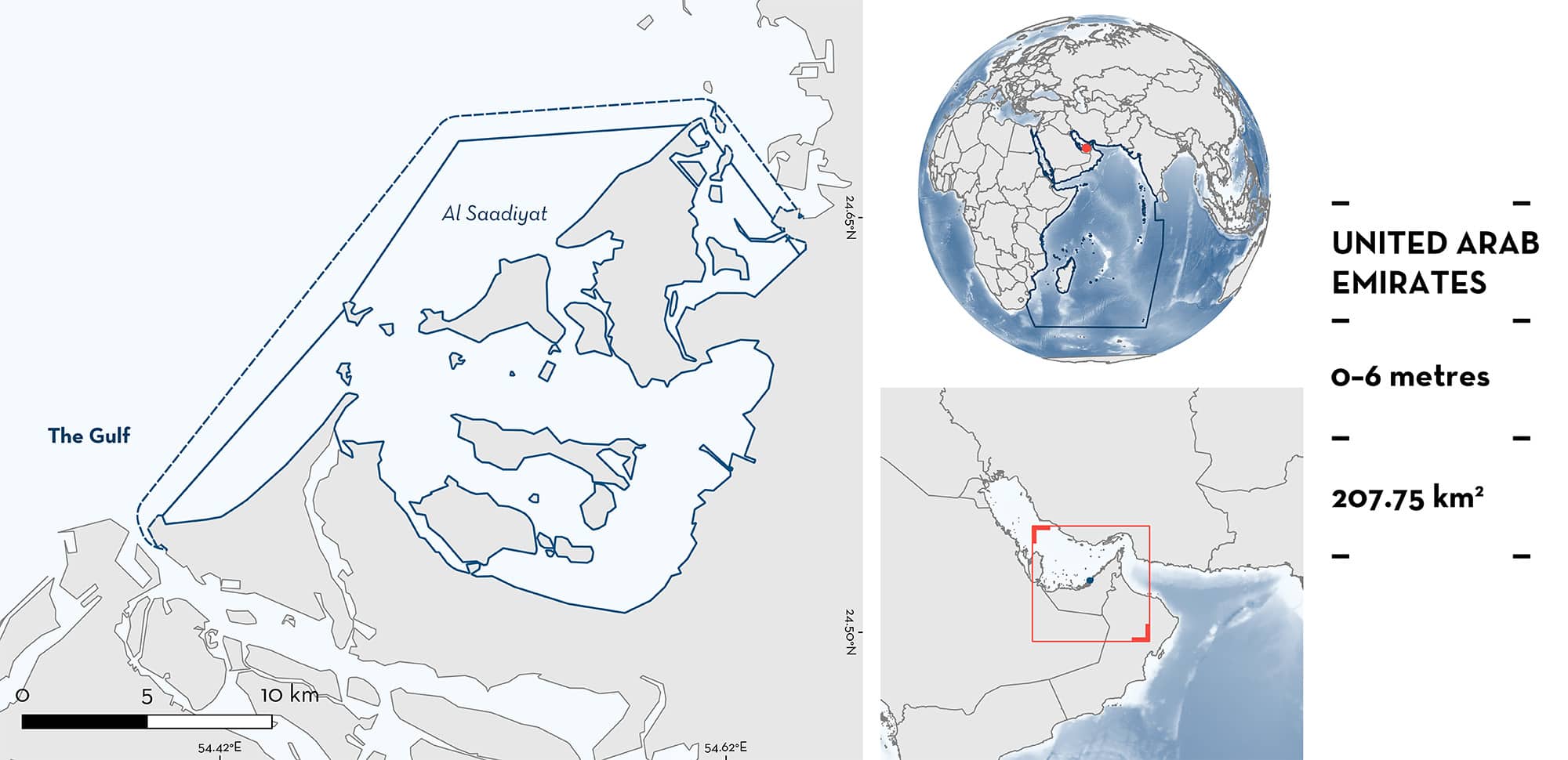ISRA FACTSHEETS
ISRA FACTSHEETS
WESTERN INDIAN OCEAN REGION
Al Saadiyat
Summary
Al Saadiyat is located in the southern Arabian/Persian Gulf (hereafter ‘the Gulf’), United Arab Emirates. It is a shallow coastal area composed of semi-enclosed bays and lagoons, that are connected to Gulf waters through deeper channels. This area partly overlaps with the Saadiyat Marine National Park. Within this area there are: threatened species (e.g., Halavi Guitarfish Glaucostegus halavi); range-restricted species (Pakistan Whipray Maculabatis arabica); and reproductive areas (Halavi Guitarfish).
Download factsheet
Al Saadiyat
DESCRIPTION OF HABITAT
Al Saadiyat is located in the southern Arabian/Persian Gulf (hereafter ‘the Gulf’), United Arab Emirates (UAE). It is a shallow coastal area composed of semi-enclosed bays and lagoons, that are connected to the open Gulf through several deeper channels. The substrate is mostly sandy or rocky with patches of coral rubble.
Localised peak winds (known as ‘shamals’) cause variations in water current speed and direction in this area, which induces significant variations in sea-bottom salinity and temperature (Cavalcante et al. 2016). Short-term shamal winds influence oceanographic processes along the coastline, resulting in the formation of large-scale eddies extending across the entire Gulf. Surface water currents form an anticlockwise gyre across the Gulf (Abdelrahman & Ahmad 1995).
The waters of the area are subject to high annual temperature ranges (range: ~15–35°C; mean: 27–28°C), high salinity (41–43‰), and relatively high turbidity (Riegl & Purkis 2012). Each summer, the Gulf is the world’s hottest sea (Riegl et al. 2011). Due to its shallow depth (mean depth = 37 m), restricted water exchange with the Indian Ocean, and the hyper-arid nature of its surrounding environment, summer Sea Surface Temperatures in the Gulf may exceed 35°C (Sheppard et al. 1992; Coles 2003), with temperatures >33°C occurring for several months (Riegl et al. 2012).
This Important Shark and Ray Area is delineated from inshore and surface waters (0 m) to 6 m depth based on the bathymetry of the area.
CRITERION A
VULNERABILITY
Two Qualifying Species considered threatened with extinction according to the IUCN Red List of Threatened Species™ regularly occur in the area. These are the Critically Endangered Halavi Guitarfish (Kyne & Jabado 2019) and Pakistan Whipray (Dulvy et al. 2017).
CRITERION B
RANGE RESTRICTED
This area holds the regular presence of Pakistan Whipray as a resident range-restricted species. This species occurs in the boreal autumn and winter in the area and is regularly encountered and caught in longline surveys (Al Hameli 2021). To determine the occurrence and distribution of sharks in the area, longline and drumline surveys were conducted opportunistically on a weekly basis from September 2019 to March 2021 (Al Hameli 2021). Over the course of the surveys, a total of 28 Pakistan Whiprays were caught (representing 39% of the total catch of sharks and rays in the area). All individuals were female measuring 30–70 cm disc width (DW; Al Hameli 2021). This species is documented in waters of Iraq and Iran, however, it has not previously been recorded in waters adjacent to the area, including in national trawl surveys of UAE waters and bi-weekly landing site surveys in Abu Dhabi from 2010–2014 (SM Al Hameli unpubl. data 2023; RW Jabado unpubl. data 2023). This species occurs primarily in the Arabian Sea Large Marine Ecosystem.
CRITERION C
SUB-CRITERION C1 – REPRODUCTIVE AREAS
Al Saadiyat is important for the reproduction of one ray species.
Frequent repeated sightings of neonate (~30–40 cm total length [TL]) Halavi Guitarfish are made on the sand banks of the area, every year, from October to May (SM Al Hameli unpubl. data 2023; including regular citizen science reports since 2010 [Elasmo Project unpubl. data 2010–2023]). The size-at-birth for this species is 29 cm TL and size-at-maturity of both males and females is 83 cm TL (Gohar & Mazhar 1964; Moore & Peirce 2013; Last et al. 2016). The season where neonates are recorded also corresponds to the time of year where adult females are highly abundant in the area (October to May), while adult males are more abundant during the rest of the year (SM Al Hameli unpubl. data 2023).
Download factsheet
SUBMIT A REQUEST
ISRA SPATIAL LAYER REQUEST
To make a request to download the ISRA Layer in either a GIS compatible Shapefile (.shp) or Google Earth compatible Keyhole Markup Language Zipped file (.kmz) please complete the following form. We will review your request and send the download details to you. We will endeavor to send you the requested files as soon as we can. However, please note that this is not an automated process, and before requests are responded to, they undergo internal review and authorization. As such, requests normally take 5–10 working days to process.
Should you have questions about the data or process, please do not hesitate to contact us.


